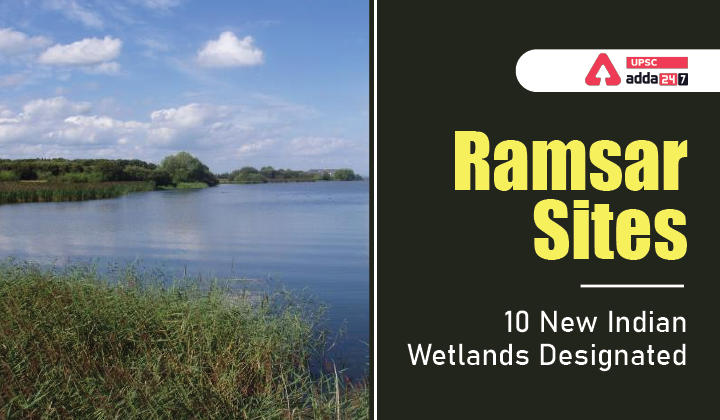Table of Contents
New Ramsar Sites- Relevance for UPSC Exam
- GS Paper 3: Environment- Conservation, environmental pollution and degradation.
New Ramsar Sites in News
- Recently, 10 more Indian wetlands were designated as wetlands of international importance (Ramsar sites), as part of Ramsar Convention.
- Few days earlier, five new Indian wetland sites were also recognised as wetlands of international importance, as part of the Ramsar Convention.
- So far, 64 wetlands covering an area of 12,50,361 ha have been designated as Ramsar Sites of International Importance from India.
Ten New Ramsar Sites in India- Key Details
- About: The 10 newly added Ramsar sites in India include-
- Six in Tamil Nadu
- One in Goa,
- One in Odisha,
- One in Madhya Pradesh and
- One in Karnataka (First Ramsar Designated Wetland in the State).
- Significance: Designation of these new Indian sites as Ramsar Sites would help in the conservation and management of wetlands and the wise use of their resources.
| Name of wetland | Area in Ha | State | |
| 1 | Koonthankulam Bird Sanctuary | 72.04 | Tamil Nadu |
| 2 | Satkosia Gorge | 98196.72 | Odisha |
| 3 | Nanda Lake | 42.01 | Goa |
| 4 | Gulf of Mannar Marine Biosphere Reserve | 52671.88 | Tamil Nadu |
| 5 | Ranganathituu BS | 517.70 | Karnataka |
| 6 | Vembannur Wetland Complex | 19.75 | Tamil Nadu |
| 7 | Vellode Bird Sanctuary | 77.19 | Tamil Nadu |
| 8 | Sirpur wetland | 161 | Madhya Pradesh |
| 9 | Vedanthangal Bird Sanctuary | 40.35 | Tamil Nadu |
| 10 | Udhayamarthandapuram Bird Sanctuary | 43.77 | Tamil Nadu |
Criteria for Designating a Wetland as Ramsar Site
As per Ramsar Convention, a wetland should be considered wetlands of international importance (Ramsar sites) based on the following criteria:
- Criterion 1: it contains a representative, rare, or unique example of a natural or near-natural wetland type found within the appropriate biogeographic region.
- Criterion 2: it supports vulnerable, endangered, or critically endangered species or threatened ecological communities.
- Criterion 3: it supports populations of plant and/or animal species important for maintaining the biological diversity of a particular biogeographic region.
- Criterion 4: it supports plant and/or animal species at a critical stage in their life cycles, or provides refuge during adverse conditions.
- Criterion 5: it regularly supports 20,000 or more waterbirds.
- Criterion 6: it regularly supports 1% of the individuals in a population of one species or subspecies of waterbird.
- Criterion 7: it supports a significant proportion of indigenous fish subspecies, species or families, life-history stages, species interactions and/or populations that are representative of wetland benefits and/or values and thereby contributes to global biological diversity.
- Criterion 8: it is an important source of food for fishes, spawning ground, nursery and/or migration path on which fish stocks, either within the wetland or elsewhere, depend.
- Criterion 9: it regularly supports 1 per cent of the individuals in a population of one species or subspecies of wetland-dependent non-avian animal species.
What are wetlands?
- According to WWF, a wetland is a place where the land is covered by water, either salt, fresh or somewhere in between.
- Marshes and ponds, the edge of a lake or ocean, the delta at the mouth of a river, low-lying areas that frequently flood—all of these are wetlands.
About Ramsar convention
- The Ramsar Convention on Wetlands is the oldest of the modern global intergovernmental environmental agreements.
- The treaty was negotiated through the 1960s by countries and non – governmental organizations concerned about the increasing loss and degradation of wetland habitat for migratory waterbirds.
- It was adopted in the Iranian city of Ramsar in 1971 and came into force in 1975.
- Since then, the Convention on Wetlands has been known as the Ramsar Convention.
- The Contracting Parties approved the Fourth Strategic Plan for 2016-2024 at COP12.
- Ramsar Convention’s broad aims are to halt the worldwide loss of wetlands and to conserve, through wise use and management, those that remain.







 TSPSC Group 1 Question Paper 2024, Downl...
TSPSC Group 1 Question Paper 2024, Downl...
 TSPSC Group 1 Answer key 2024 Out, Downl...
TSPSC Group 1 Answer key 2024 Out, Downl...
 UPSC Prelims 2024 Question Paper, Downlo...
UPSC Prelims 2024 Question Paper, Downlo...




